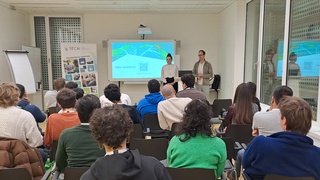The interdisciplinary research in SECAI is organized in five Research Focus Areas. Each area combines several AI-related research fields, thereby bringing together the diverse strengths of researchers in SECAI.
Composite AI
While traditional AI was driven by the search for one single paradigm to create intelligent behavior, most modern AI success stories embody a synergistic combination of multiple paradigms, known as hybrid or composite AI. While "pure" methods achieve a certain success, recent composite approaches accomplish similar performance at much lower cost. As widespread as hybrid approaches are in AI today, the combination of methods is often a feat of engineering, whereas a principle understanding of composite methodologies and their effective use is lacking. In SECAI, we assemble internationally recognized experts across a broad spectrum of hitherto segregated AI approaches, ranging from symbolic methods (especially knowledge representation and logical modeling) to machine learning (especially neural network and statistical learning).
AI Compute Paradigms
The recent leaps of AI have been inextricably connected to the advancement of computing hardware. The present wave of AI breakthroughs started with the insight that graphics hardware (GPUs) can be harnessed to scale known machine learning (ML) methods to much larger data sizes, and AI has since been associated with massive computation usage. Specialization is now a major trend in microelectronics: CPUs and GPUs today compete with field-programmable gate arrays (FPGAs) and application-specific integrated circuits (ASICs). The success of innovative hardware crucially depends on embedding: (1) the physical embedding of the hardware in intelligent devices and (2) the logical embedding of AI algorithms in the computational framework of the underlying hardware. SECAI aims at dealing with both aspects by developing future AI compute paradigms.
Intelligent Medical Devices
Looking at prominent AI breakthroughs as well as failures, it is apparent that the guidance and specificity of a relevant application domain is at least as essential as hardware and algorithms. This scope is provided by the multitude of exciting and prospering uses of AI in life science and medicine. The field's demanding requirements for hardware (small, energy-efficient, real-time capable) and methods (robust, scalable, trustworthy) make it an ideal testbed for interdisciplinary AI solutions.
AI Methods for Health
With the growing amount and complexity of data in healthcare, AI methods become increasingly prevalent in biomedical research, promising to generate new insights by revealing latent patterns hidden in the data. Applications range from computer-aided drug design and medical image analysis to diagnostic expert systems and cyber-medical systems. As the success of the employed methods is very sensitive to the quality of the input data, solutions for large-scale data management are required.
Societal Framework for AI
Technological breakthroughs can only unfold their practical benefits if they are aligned with the broader frameworks that govern societal acceptance, legal approval, and economic viability. The European Commission's 2021 proposal for an Artificial Intelligence Act has drawn attention to the formidable difficulty of regulating AI in a way that protects citizens from risks like discrimination and still fosters innovation and economic growth. Through its focus on medicine and health care, SECAI deliberately connects to a field that—like AI—is inseparable from far-reaching questions of ethics, law, and societal acceptance.This allows SECAI to build on the substantial experience in topics like data protection and regulatory affairs in medical contexts from both, TU Dresden and Leipzig University. We are also going to focus on political aspects and philosophy.




